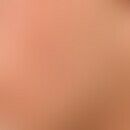Synonym(s)
DefinitionThis section has been translated automatically.
Type IV or IgE-mediated reaction to sulphur dioxide, its aqueous solution, sulphurous acid or derived salts (= sulphite, E numbers 220-224 and 226-228). Sulphites are used for the preservation of foodstuffs. There is a declaration obligation only from 50 mg/kg, for wine from 400 mg/l (see also wine allergy).
Their use in food is regulated in Europe by EU Directive No. 95/2/EC, in cosmetic products by EU Regulation 123/209.
Their use in medicinal products is regulated in the monographs of the European Pharmacopoeia (Ph.Eur.8.0). The maximum workplace concentration (MAK value) for SO2 is 1.0 ml/m³ (ppm).
Occurrence/EpidemiologyThis section has been translated automatically.
In larger collectives (n =12,156 patients) with mainly contact allergies a sensitization rate of 2.94% was found. In other epicutaneous test collectives positive test reactions to sulfites were found between 1.1% and 4.5%. With regard to the origin of the contact substance categories, external drugs, cosmetics, sunscreen preparations, preservatives, disinfectants were relevant in this order.
An occupational dermatological classification (about 10% of the sensitized persons) could be established for the following professions: food industry, beverage, leather and textile industry, wood and paper industry, rubber industry, etc.
You might also be interested in
EtiopathogenesisThis section has been translated automatically.
The importance of sulphites as contact allergens has been controversially evaluated in the past. Positive test reactions were frequently evaluated as irritant; sulphite allergies were generally evaluated as sulphite hypersensitivity. More recent test results do not seem to confirm this view. The German Contact Dermatitis Research Group considers sodium metabisulphite 1% in vaseline as the most suitable epicutaneous test substance (Note: this substance is included in the ophthalmic test series of the German Contact Allergy Group).
TherapyThis section has been translated automatically.
LiteratureThis section has been translated automatically.
- García-Gavín J et al (2012) Allergic contact dermatitis caused by sodium metabisulfites: a challenging allergen: a case series and literature review. Contact dermatitis 67:260-269.
- Häberle M et al (2016) Contact allergy to sulfites: clinical and occupational relevance - new data from the German Contact Dermatitis Research Group and the Information Network of Departments of Dermatology (IVDK). J Dtsch Dermatol Ges 14:938-941.
- Przybilla B et al (1987) Sulphite hypersensitivity. Dermatologist 38: 445-448
- Sergeant P et al (2003) Food safety of allergic patients in hospitals: implementation of a quality strategy to ensure correct management. Allerg Immunol 35: 120-123
Disclaimer
Please ask your physician for a reliable diagnosis. This website is only meant as a reference.




